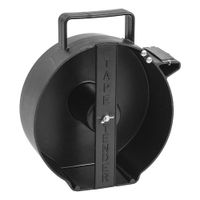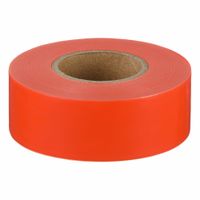Call +(254) 703 030 000 / 751 483 999 / 721 704 777
- Home
- Security
- Access Barriers Crowd Control
- Barrier Flagging Tape
.....Read More
Frequently Asked Questions
What is barrier tape used for?
Barrier tape is used for marking off areas to restrict access, indicate hazards, or provide guidance. It is commonly employed in construction sites, crime scenes, and public events to ensure safety and control the flow of people. The tape is often brightly colored, such as yellow or red, and may include warning messages like "Caution" or "Do Not Enter." In construction, it helps prevent unauthorized entry into dangerous zones. At crime scenes, it preserves evidence by keeping the area secure. During public events, it guides attendees and delineates specific areas. Barrier tape is also used in industrial settings to highlight hazardous zones or equipment.
How is caution tape different from flagging tape?
Caution tape and flagging tape serve distinct purposes and have different characteristics.
Caution tape, often referred to as barrier tape or warning tape, is typically made from durable polyethylene or polypropylene. It is designed to be highly visible, usually featuring bright colors like yellow or red with bold black lettering. The primary function of caution tape is to alert and restrict access to hazardous or restricted areas, such as construction sites, crime scenes, or areas undergoing maintenance. It often bears printed warnings like "Caution" or "Danger" to convey the nature of the hazard. Caution tape is usually wider and more robust to withstand outdoor conditions and prevent unauthorized entry.
Flagging tape, on the other hand, is a non-adhesive, brightly colored tape used primarily for marking and identification purposes. It is made from lightweight materials like vinyl or plastic and comes in a variety of colors, often without any printed text. Flagging tape is commonly used in forestry, surveying, and landscaping to mark boundaries, trails, or specific points of interest. Its primary function is to provide visual markers rather than to restrict access. The tape is typically narrower and less durable than caution tape, as it is not intended to serve as a barrier.
In summary, caution tape is used for warning and restricting access to hazardous areas, featuring bold colors and printed warnings, while flagging tape is used for marking and identification, available in various colors without text, and is less robust.
What are the standard colors of barrier tape and their meanings?
Barrier tape, also known as caution tape or warning tape, uses color coding to convey specific messages:
1. **Yellow/Black**: Indicates caution. Used to warn of potential hazards or to restrict access to areas where safety precautions are necessary.
2. **Red/White**: Signifies danger or prohibition. Used in areas where there is a significant risk of injury or to denote areas that are off-limits.
3. **Blue/White**: Used for informational purposes. Often seen in areas where specific instructions or information is provided, such as construction sites.
4. **Green/White**: Indicates safety. Used to mark safe areas or to provide directions to safety equipment or exits.
5. **Orange/White**: Used in areas where there is a need for attention due to construction or maintenance work. It highlights areas where workers are present.
6. **Black/White**: Used for housekeeping and organizational purposes. It can denote areas that need to be kept clear or organized.
7. **Purple/Yellow**: Used to indicate radiation hazards. It marks areas where radioactive materials are present.
These colors help ensure safety by providing clear visual signals to individuals, guiding them on how to proceed or what precautions to take in various environments.
How do you properly install barrier tape?
To properly install barrier tape, follow these steps:
1. **Identify the Area**: Determine the specific area that needs to be cordoned off. This could be for safety, crowd control, or to mark a restricted zone.
2. **Select the Tape**: Choose the appropriate type of barrier tape. Options include caution tape, danger tape, or custom-printed tape, depending on the situation.
3. **Gather Materials**: You will need barrier tape, stakes or posts, and possibly a hammer or mallet if the ground is hard.
4. **Plan the Layout**: Decide on the path the tape will take. Ensure it forms a clear boundary around the area. Consider entry and exit points if needed.
5. **Install Stakes or Posts**: Place stakes or posts at regular intervals along the planned path. The distance between them depends on the terrain and the length of the tape, but generally, 6 to 10 feet apart is effective.
6. **Attach the Tape**: Start at one end and unroll the tape, attaching it to the first stake. Secure it with a knot or tape. Continue unrolling and attaching the tape to each subsequent stake, keeping it taut but not overly tight to prevent tearing.
7. **Adjust Height**: Ensure the tape is at a visible height, typically between waist and chest level, to ensure it is easily seen.
8. **Secure the Ends**: At the final stake, cut the tape and secure it firmly. Ensure all connections are tight to prevent the tape from sagging or blowing away.
9. **Check Visibility**: Walk around the perimeter to ensure the tape is visible from all angles and adjust if necessary.
10. **Regular Inspection**: Periodically check the tape for damage or sagging and make adjustments as needed to maintain effectiveness.
Can barrier tape be reused?
Barrier tape is generally designed for temporary use and is not intended for reuse. It is typically made from lightweight materials like polyethylene or polypropylene, which are durable enough for short-term applications but may not withstand multiple uses. The tape can become damaged, torn, or dirty after initial use, compromising its visibility and effectiveness. Additionally, the adhesive properties, if any, may degrade, making it difficult to secure the tape properly in subsequent uses.
Reusing barrier tape can also pose safety risks. If the tape is not in optimal condition, it may not effectively communicate hazards or boundaries, potentially leading to accidents or misunderstandings. In professional settings, such as construction sites or emergency situations, using compromised barrier tape could result in non-compliance with safety regulations.
However, if the tape remains intact and clean after its initial use, and if it can be securely fastened, it might be reused in non-critical applications where safety is not a primary concern. In such cases, careful inspection is necessary to ensure that the tape is still visible and functional.
Ultimately, while it is technically possible to reuse barrier tape under certain conditions, it is generally not recommended due to potential safety and effectiveness concerns.
What materials are barrier tapes made from?
Barrier tapes are typically made from a variety of materials, each chosen for specific properties that suit different applications. The most common materials include:
1. **Polyethylene (PE):** This is the most widely used material for barrier tapes. It is lightweight, flexible, and resistant to moisture and chemicals, making it ideal for outdoor use. Polyethylene tapes are often used for marking off construction sites, roadworks, and hazardous areas.
2. **Polypropylene (PP):** Similar to polyethylene, polypropylene is also lightweight and durable. It offers excellent resistance to fatigue and is less prone to stretching, which makes it suitable for longer-term applications. It is often used in environments where the tape needs to withstand more wear and tear.
3. **Nylon:** Known for its strength and elasticity, nylon is used in barrier tapes that require high tensile strength. It is more expensive than polyethylene and polypropylene but offers superior durability and resistance to abrasion.
4. **PVC (Polyvinyl Chloride):** PVC tapes are known for their durability and resistance to weathering, chemicals, and UV light. They are often used in environments where the tape needs to maintain its integrity over time, such as in industrial settings.
5. **Biodegradable Materials:** With increasing environmental concerns, some barrier tapes are now made from biodegradable materials. These tapes are designed to break down over time, reducing environmental impact. They are typically used in temporary applications where environmental sustainability is a priority.
Each material offers distinct advantages, and the choice depends on factors such as the intended use, environmental conditions, and budget considerations.
Where can I buy barrier tape and dispensers?
You can purchase barrier tape and dispensers from a variety of sources, both online and in physical stores. Here are some options:
1. **Online Retailers**: Websites like Amazon, eBay, and Walmart offer a wide range of barrier tapes and dispensers. These platforms provide customer reviews, competitive pricing, and often fast shipping options.
2. **Specialty Safety Supply Stores**: Companies like Uline, Grainger, and Global Industrial specialize in industrial and safety supplies, including barrier tapes and dispensers. They offer a variety of options tailored to different needs and industries.
3. **Home Improvement Stores**: Chains such as Home Depot and Lowe's carry barrier tapes and dispensers in their physical locations and online. These stores often have knowledgeable staff who can assist with selecting the right product for your needs.
4. **Office Supply Stores**: Staples and Office Depot may carry barrier tapes and dispensers, especially those used for crowd control or office safety.
5. **Local Hardware Stores**: Smaller, independent hardware stores might stock barrier tapes and dispensers, particularly if they cater to contractors or construction professionals.
6. **Construction Supply Stores**: Outlets that focus on construction materials and tools often have a selection of barrier tapes and dispensers, suitable for job sites and safety compliance.
7. **Direct from Manufacturers**: Some manufacturers sell directly to consumers through their websites, offering a range of products and sometimes bulk purchasing options.
8. **Safety Equipment Suppliers**: Companies that specialize in personal protective equipment (PPE) and safety gear often carry barrier tapes and dispensers as part of their product lineup.
When purchasing, consider the specific requirements such as tape material, color, length, and dispenser type to ensure it meets your needs.


